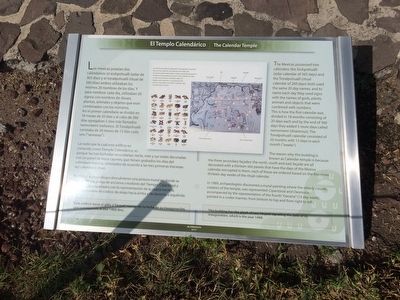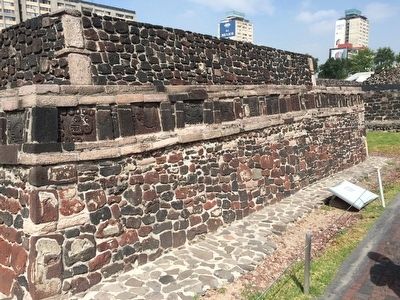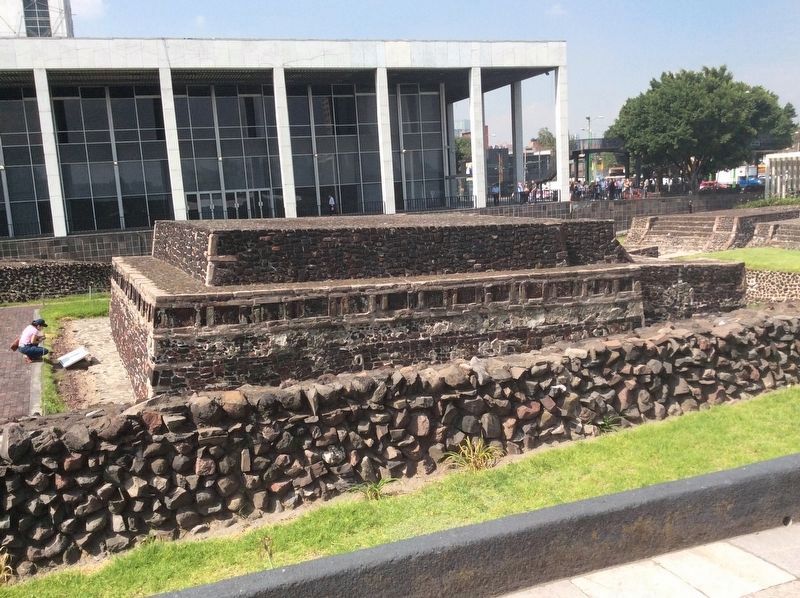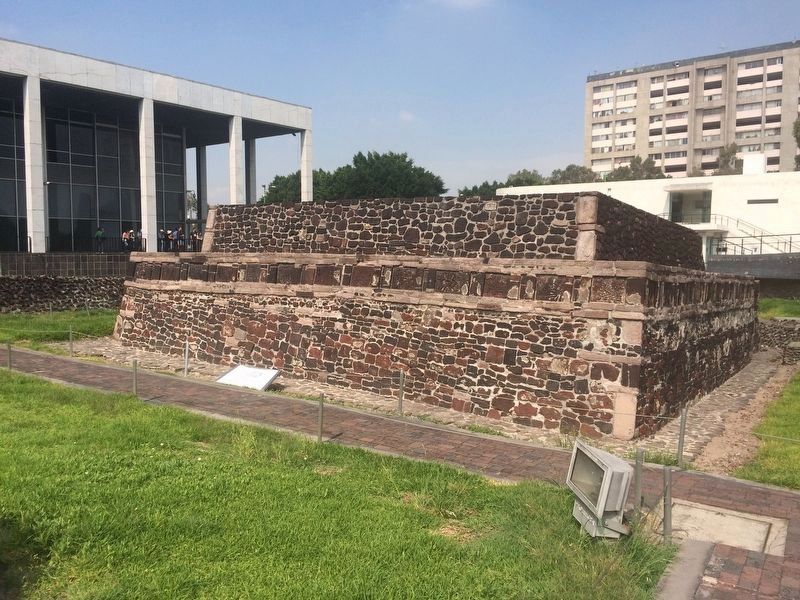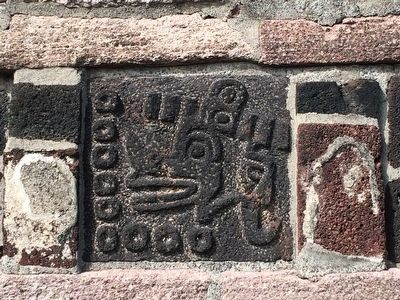Colonia Tlatelolco in Ciudad de México, Mexico — The Valley of Mexico (The Central Highlands)
The Calendar Temple
El Templo Calendárico
Los mexicas poseían dos calendarios: el xiuhpohualli (solar de 365 días) y el tonalpohualli (ritual de 260 días) ambos utilizaban los mismos 20 nombres de los días. Y para nombrar cada día, utilizaban 20 signos con nombres de dioses, plantas, animales y objetos que eran combinados con los números. Así el primer calendario se dividió en 18 meses de 20 días y al cabo de 360 días agregaban 5 días más llamados nemontemi (nefastos). El Tonalpohualli constaba de 20 meses de 13 días cada uno (“semanas”).
La razón por la cual este edificio es conocido como Templo Calendárico, es porque las tres fachadas secundarias: norte, este y sur están decoradas con un panel de trece cajones, que tienen grabados los días del calendario mexica, ordenados de acuerdo a las tres primeras trecenas del calendario ritual.
En 1989, los arqueólogos descubrieron una pintura mural en donde se representó a la pareja de ancianos del Tiempo: Cipactónal y Oxomoco, acompañados con la representación de cuarta trecena, pintada a manera de códice, de abajo hacia arriba y de derecha a izquierda.
Este edificio tiene el glifo 2 Técpatl marcarndo la fecha de su inauguración, que corresponde al año 1468 dne.
Pie de dibujo:
¿Cómo funcionaba el calendario? Por ejemplo, el primer dia era Uno Cipactli, Dos Ehécatl, Tres Calli y así sucesivamente hasta el Trece Ácatl; momento en que los números comenzaban de nuevo: Uno Océlotl. Por ello, un dia con el mismo numeral y signo se repetía sólo cada año. La conjunción de ambos calendarios en el dia 1 Cipactli sólo sucedía cada 52 años.
(Dibujos de los símbolos de los días y un dibujo de los dioses Oxomoco y Cipactónal con glifos de días a su alrededor.)
The Mexicas possessed two calendars: the Xiuhpohualli (solar calendar of 365 days) and the Tonalpohualli (ritual calendar of 260 days) both used the same 20 day names, and to name each they used signs with the namges of gods, plants, animals and objects that were combined with numbers. This is how the first calendar was divided in 18 months consisting of 20 days each and by the end of the 360 days they added 5 more days called nemontemi (disastrous). The Tonalpohualli calendar consisted of 20 months with 13 days in each month (“weeks”).
The reason why the building is known as the Calendar Temple is because the three secondary facades: the north, south and east façade are all decorated with a thirteen slot panels that have the day of the
Mexica calendar encrypted in them, each of these are ordered based on the first three thirteen day weeks of the ritual calendar.
In 1989, archaeologists discovered a mural painting where the elderly couple, creators of the temple (sic, Time), was represented: Cipactónal and Oxmoco, accompanied by the representation of the fourth “trecena” (13 day week), painted in a codex manner, from bottom to top and from right to left.
This building has the glyph of two Técpatl signaling the date of its inauguration, which is the year 1468.
English translation of captions:
How did the calendar work? For example, the first day was One Cipactli, then Two Ehécatl, then Three Calli and so on until 13 Ácatl; at this point the numbers start over again: One Océlotl. That is why a day with the same number and sign only repeats once a year. The conjunction of both calendars on the day 1 Cipactli only happens every 52 years.
(Drawings of the day symbol glyphs and a drawing of the gods Oxomoco and Cipactónal surrounded by day glyphs.)
Topics. This historical marker is listed in these topic lists: Anthropology & Archaeology • Man-Made Features. A significant historical year for this entry is 1468.
Location. 19° 27.049′ N, 99° 8.255′ W. Marker is in Ciudad de México. It is in Colonia Tlatelolco. The marker
is at the Tlatelolco Archeological Site on Eje Central near the intersection with Avenida Ricardo Flores Magón. Touch for map. Marker is in this post office area: Ciudad de México 06900, Mexico. Touch for directions.
Other nearby markers. At least 8 other markers are within walking distance of this marker. The Palace (a few steps from this marker); Tlatelolco’s great temple (“Templo Mayor”): A mirrored image of Tenochtitlan (a few steps from this marker); Tzompantli altar (“flag of heads”) of the south. (a few steps from this marker); Superimposed altars (within shouting distance of this marker); Full color Tlatelolco: The temple of the paintings (within shouting distance of this marker); The Tlatelolco Lovers (within shouting distance of this marker); Ehécatl Quetzalcóatl: attracting rain and fertility (within shouting distance of this marker); Tlatelolco: a well-planned city (within shouting distance of this marker). Touch for a list and map of all markers in Ciudad de México.
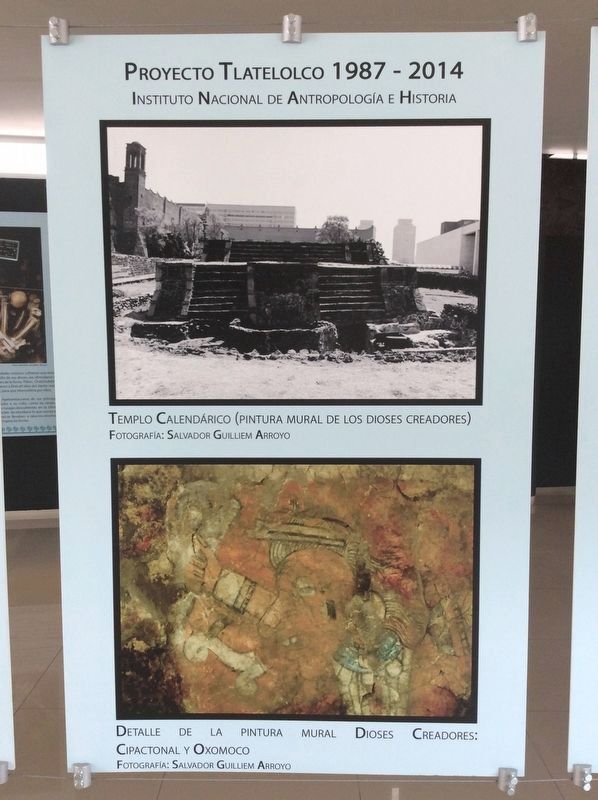
Photographed By J. Makali Bruton, August 7, 2017
6. A photo of The Calendar Temple and the mural mentioned in the marker text
These two photos are from the small site museum at Tlatelolco and show a photo of the Calendar Temple towards the east and a portion of the mural found there of Cipactonal and Oxomoco. Both photos are by Salvador Guilliem Arroyo.
Credits. This page was last revised on April 17, 2020. It was originally submitted on January 4, 2016, by J. Makali Bruton of Accra, Ghana. This page has been viewed 378 times since then and 27 times this year. Photos: 1, 2. submitted on January 4, 2016, by J. Makali Bruton of Accra, Ghana. 3. submitted on August 12, 2017, by J. Makali Bruton of Accra, Ghana. 4. submitted on August 13, 2017, by J. Makali Bruton of Accra, Ghana. 5. submitted on January 4, 2016, by J. Makali Bruton of Accra, Ghana. 6. submitted on August 12, 2017, by J. Makali Bruton of Accra, Ghana.
